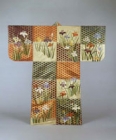Japanese Gallery (Honkan) Room 9
April 24, 2007 (Tue) - June 17, 2007 (Sun)
Kazura-mono is a type of play where an actor wearing a wig (kazura) plays the leading role of the young heroine. These lyrical dramas were usually the third (sanban) in a sequence of five plays, they are also known as sanban-mono. "Kakitsubata" is a kazura-mono drama with a young village woman as the main character in the first half and an iris's (kakitsubata) spirit as the main character in the second half.
The drama begins with a traveling monk at Yatsuhashi, a spot famous for beautiful irises (kakitsubata). A village woman appears out of nowhere and tells him the origin of the area.
In the second half of the drama, the woman appears in the form of the spirit of an iris (kakitsubata) wearing a choken, which was supposed to be the karakoromo worn by Narihira's lover, and swinging its wide sleeves as she dances. She tells the monk that Narihira was in fact an incarnation of a bodhisattva, and thanks to his poem, she could be reborn in the Pure Land despite she was a plant.
The dance of the spirit wearing Ariwara no Narihira's crown and the karakoromo represents the deep love between the two lovers.

